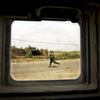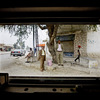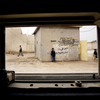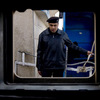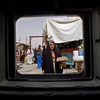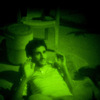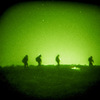A Conversation with Benjamin Lowy
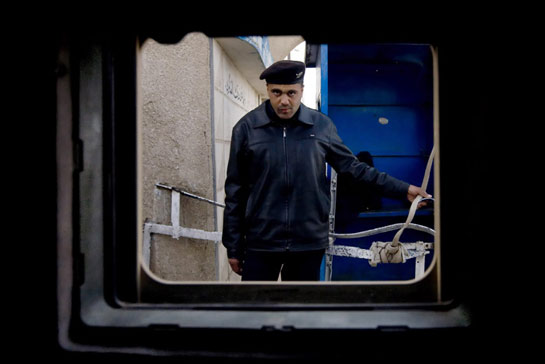
Benjamin Lowy’s new book Iraq | Perspectives is due to be released later this year. Given photojournalism has been in the news (again) recently, I approached Ben to talk about his book, his work in general, and about photojournalism. (more)
Jörg Colberg: There is no shortage of crises around the globe, yet in many ways photojournalism looks like one of the most thankless jobs in photography right now. Money has dried up, and almost every day, there is yet another incarnation of the “photojournalism is dead” debate. So I thought I’d start off by asking you about your original motivations for becoming a photojournalist? Why photojournalism? What attracted you to the field?
Ben Lowy: Well, I originally wanted to be a comic-book artist. I even went to art school for illustration, before realizing that I would never be as good as I wanted to be, or needed to be. At the same time, I was searching for a way to make my drawings work - I would go to this bookstore in St. Louis, MO - where I went to school - called Library Limited. It’s out of business now, but it opened doors in my life. It was there that I used to pull out fashion and nude photo books - like Howard Schatz’s Nude Body Nude, and I would trace the figures and use them in my illustrations. One day, because fashion books are for the most part, tall and thick, I pulled out Nachtwey’s Inferno. And I sat for hours in the store consumed with what I saw. Beauty and horror merged together, the randomness of life multiplied by the chaos of war. After that… I knew what I wanted to do. I took off from school, moved to Paris with my girlfriend at the time, and taught myself photojournalism. Or what I thought was photojournalism.
But there has to be more than that. My transformation from a nerdy comic book wannabe to a nerdy photographer had more twists and turns. I was always aware of the world around me. I was brought up constantly reading the news and debating world events at the dinner table. I’m a first generation American, my father was born in a concentration camp, and that history, what happened to our family, was a constant reminder of the burden of the past and its need to documented and remembered. So maybe I was just waiting for a firm kick in the ass to get me down this path.
JC: How did you teach yourself photojournalism? What does that entail, being a photojournalist?
BL: Oh man, I could answer these two questions with all the rehashed cliches that everyone always spits out. Let’s be honest. I’ll start with your first question since it’s easier. I sat in book stores and looked at work for months. I went to museums. I was living in Paris, the birthplace of Photography, so I had some decent venues to explore and learn from. But it was taking those first pictures, of forcing myself to confront curious subjects on the street, of figuring out how to articulate a story visually. But mostly it was just cumulative experiences that helped me “learn” what I was trying to do, to be a “photojournalist.” But what is “it” that you ask? Am I a documentary photographer, are they the same thing? Am I an artist, a journalist, a halfbreed mix of both?
JC: Photojournalism is also a very dangerous activity, at least once you go to places where there are live bullets. You just became a dad for the second time (congratulations!) - how do you handle the dangers of your job given that there is a family waiting at home?
BL: Thanks. That’s a really tough question to answer. One I struggle with every time I look in the mirror. I know what work I want to do. What work is important. I know what experiences in the field make me feel alive. When I close my eyes and day dream, I know what I want. At the same time, my family has grown and now the dreams, those goals, have changed and morphed. I can’t deny I still want to shoot war, to shoot these stories that most sane family men and women won’t venture close to. But at the same time, I love my child falling asleep in my arms drooling on my shoulder, that way he screams my name and runs to the door when I walk into the house, I can’t give that up. And so that changes things.
The last conversation I had with Tim Hetherington was on an Egypt Air flight back to NY on April 1. It was about family, it was about children and settling down, and if it was possible or just selfish to continue working in this field.
I don’t know how you can balance war coverage and living out of a suitcase for months on end, and having a family on another continent waiting for you. Too many journalists are single or divorced and have kids who hate them. I don’t want that. There has to be a middle ground.
After Tim and Chris were killed, my wife and I spoke to a marriage councilor, to try and work out the different ways we were grieving. It was tough.
But maybe I can cover war without going to the front lines - like Joachim Ladefoged’s Albanians book - a great body of work on a violent conflict that doesn’t have a single violent picture in it.
After all, its hard to photograph a bullet flying through the air.
JC: I’ve never been to one (and hopefully never will be) but from what I can tell war seems to have this weird attraction to some people to go and take those crazy picture that we then see on the covers of newspapers. But wars usually don’t just start out of nowhere, there tends to be a story before them, often a very complex one that, had we known about it beforehand, might actually have changed quite a few things. I am often under the impression that many photojournalists don’t really like those kinds of stories, of conflicts that have not yet broken out, of simmering discontents, where the pictures might not be so dramatic on their own, but the story itself might have quite a bit more layers than a hot war. Wouldn’t that be something to look for to be a bit safer? Not the currently most active war, but the places where tempers are flaring - often places we are then surprised to “suddenly” find at war?
BL: In general it’s very hard to visually illustrate an abstract idea - like simmering anger, or expressing with a photograph a story some local told you about a far off injustice. For the most part I think that many of us are prisoners to money and funding. It’s difficult to go to some far off place to trace simmering anger and justify the expenses of living there to a client that is barely getting by. Newspapers and most magazines work within a fairly bad business model of selling a product that people don’t want - bad news. And you can’t work on bad news long term, there is always more graphic bad news, more action, and the modern audience doesn’t have an attention span for simmering anger.
That being said, I think it’s incorrect to say that photojournalists “don’t like” longer term stories. In fact I would like to believe that a long-term project is something that we all strive to work on. But our industry is cut throat competitive, and there is a lot of pressure to do the next “hot shit” story and justify one’s place in the pecking order. But that’s why grants were invented, or why people are turning to Kickstarter or Emphasis.
And yes, simmering anger would be a lot safer than outright hostilities.
JC: You have a book coming out in the fall (Iraq | Perspectives, Duke University Press) that showcases the work you’ve done in Iraq where you were “embedded” with US troops. In many ways, the photography in that book seems to echo how that war was understood in the larger public: Almost as if it was happening in another world. The Humvee photographs almost look as if you had been a deep-sea diver, photographing what was beyond the safety of the steel capsule you had to stay in to be safe. Can you talk a little about what made you take these particular photographs?
BL: Originally I began shooting out my car window because, at the time, it was the only way to photograph the Iraqi “street.” It was too dangerous to just simply walk. But I began shooting out these windows, mostly because my mother kept asking me what Iraq was like. What Baghdad was like. The only pictures she saw from me or other journalists were embeds, raids, bombs sites, and hospitals. So this was my attempt to photograph something different, to show her, to show people in the West, a different Iraq. At the same time, the framing mechanism of the window itself became part of the picture, it became a metaphor for the barrier between our worlds.
JC: The framing, however, certainly does serve as a barrier. The window obviously serves its purpose of giving you safety, but in the images it also presents Iraq as some sort of stage, as something that is disconnected from what’s going on inside the Humvee - whereas in reality things were (and still are) quite connected. Did you never worry a little bit about whether this framing would make things look too much as if it was out of another world, a world we have no connection to? I’m asking this in particular since so many people seem to have no connection to these wars - which, of course, is something the George W. Bush White House actively wanted. But this has, I think, managed to create a disconnect between the public and the soldiers: Unless you have a family member in the military you literally wouldn’t know there’s a major war going on.
BL: Iraq was a stage. And it was another world, a world most Americans had very little impetus to care out, to wonder about. It was a war that in all honesty, impacted the wallets of more Americans than impacted their lives outright. Much of the discussion of Iraq was abstract, and most Americans turned the channel. So while one interpretation of my images may be a disconnected barrier, I’m still of the mind that by presenting Iraq in a particular way - different that what we journalists tried to force feed the public - I will be able to connect to an audience not used to seeing this form of presentation. You could make that argument that Im taking advantage of the disconnect, or perhaps abusing it, relying on it to create an image that brings back a viewer teetering on the edge of apathy. But I’m not worried that I’m presenting an ever greater disconnect.
JC: This feels like an old debate, but I’m going to ask it nevertheless. I do understand that being embedded with US soldiers guaranteed your safety, but I am wondering how it might interfere with the “journalism” bit that is part of the word “photojournalism.” Isn’t that an issue, if we only see things from our side? Mind you, I don’t mean to say that you weren’t interested in giving a wider view, but being embedded with US troops might have create a huge impediment to doing so.
BL: First off, I couldn’t embed with Iraq insurgents. I can’t embed with Al Qaeda.
That being said, I think anytime someone is following a subject, be it a written journalist, a film maker, or a photographer, we are embedded. “Embed” is just a word. Yes, the US military took it to new heights, something bureaucratic and political. A creation of the Rumsfeld Pentagon that helped control the flow of information because they were able to spoon-feed it to news venues. But in reality, did the journalists who entered Iraq as “unilaterals” create anything different? They latched onto units and made the same pictures of war.
A few days ago I was on the campaign trail with a US Presidential candidate, and I was, for all intent and purposes - embedded.
JC: I don’t think I want to let you get away with that. We can probably agree on the fact that once you’re working with someone you are, to some extent, embedded. But I wager that the team around that presidential candidate was not literally standing between you and a very hostile environment where, without their support, you’d get shot to pieces in no time. Didn’t this extreme dependence on the military for your own safety create a problem for your photojournalistic independence?
BL: Have you seen tea party supporters? I bet I would get shot to pieces, especially wearing my liberal lame-stream media rainbow recycled t-shirt.
But in all seriousness, in many ways I was - and many still are - dependent on the US or NATO forces to work in Iraq and Afghanistan. Journalistic independence, as an abstract idea, is worthless if the journalist is dead or kidnapped. There are way too many examples of people trying to tell the story in ridiculously extreme situations and paying the price with their freedom.
If I wasn’t embedded with a presidential candidate, they might very well leave a venue without me. And being with a specific group is what the embed is about. I am representing that group, that perspective if you will. To think that one would be getting an unobstructed view of the entirety of the war by spending it with one side is obviously wrong. I think journalists had to go into the embeds expecting to tell the American military viewpoint. If your eyes were wide open when you made that choice, then there was room to grow. Chris Hondros managed to make an image that encapsulated the horror, stupidity, and futility of Iraq with one image while on an Embed. And yes, it caused him headaches, but he still managed to do many more embeds after that. Stephan Zaklin, who isn’t working in photojournalism currently, made amazing pictures during the battle of Fallujah and was asked to leave his embed while the fighting was ongoing, more so because the military had a knee-jerk reaction to the image of a dead soldier. But hey, Robert Capa, arguably the most celebrated photojournalist ever, was embedded with the allied forced for the D-Day Invasion. Some perspectives, some stories, can’t be told from outside the fold - both for safety and access.
JC: Looking back, what lessons do you think can be drawn from the Iraq war and how it was covered in our media? Unlike the vast majority of the readers of this site - and me - you were in Iraq, you did take a lot of photographs, and you saw how the war was covered, you saw how the public reacted to it. Given the amount of time you spent there were you able to get your story across?
BL: I think the most important thing we need to remember is the concept of relative realities. That what happens in NY and Iraq are separated by vast cultural, economic, and geographic differences, and getting people so disconnected to care about others is very hard. By providing information I hope, at the very least, that I was able to record the war for history’s sake. Did I educate? Did I inform and affect? I’m not so sure. I’m not so sure that people want to be affected.
JC: I almost asked this earlier, so I might as well do it now: I often think that photojournalism is such a thankless task because many people don’t want to be affected. That must be so frustrating! You risk your life to get pictures, and then people can’t be bothered to look or to care. How do you deal with that?
BL: You’re right, too many people don’t want to look. But I don’t know them all. I know that the people I surround myself with, my friends and family, do care. They think what we do is worthwhile, that it’s worth it. Sometimes I go on a random assignment, or I’m in some corner bar someplace and I end up explaining to people what I do. Maybe they didn’t care before, or won’t the next day, but for that instant that I’m talking about Iraq or Darfur, they listen.
Whenever I get back from a long trip, my wife and I have this ritual. It sort of grounds me back home, lets me back in psychologically. Part of this ritual involves sitting on the steps of union square park in NYC and watching people going about their daily lives. Watching them shopping for clothes, for food, whatever - mostly watching their complete obliviousness to the hardships of another place thousands of miles away. Initially I get angry, but then I realize, that it’s all relative. That this is part of life, that most people are oblivious, because there is no other way to live. You can’t care about everyone everywhere.
JC: Part of your more recent work involved using an iPhone to take photographs. I’m curious about your motivation for that.
BL: Well, there are several reasons behind incorporating the iPhone into my “camera bag.” Firstly, the iPhone is a lot smaller that any other camera I ever carried around. It’s a matter of convenience that I first began to use it. I don’t have to run after my kids and dogs with my camera strap flapping around.
But with my more structured work in Afghanistan and, recently, Libya - reportage with the iPhone took on new life.
Small mobile phone cameras are innocuous and enable a far greater intimacy with a subject. And while I covered Libya with a traditional 35mm, it was a liberating experience to point and shoot with a small device, unhampered by camera bags full of gear.
As photojournalists our responsibilities include not just communicating content, but also creating an aesthetic, a visual narrative that will capture our audience’s attention.
The public today is more visually sophisticated than ever before. The overwhelming dearth of information available on the internet tends to weaken the impact of content. Important stories get lost in the fray. So as photographers - as creatives and not just journalists - we have the added task of developing a connection to our audience. We need an image that will engage the viewer, that makes our audience question what they are seeing, that allows them to take a step closer to the image and thus the content.
At the same time, using my iPhone allowed me transmit images from the field updating my blog. Embracing this new paradigm of journalism - no middle man, no publisher - I posted images from Libya and gained over 500 followers in a week, regular curious people - Libyans, Americans, Europeans - who bypassed traditional traditional news sources.
JC: I’m just wondering whether using the iPhone, in particular with an app that creates a certain look, does not in fact create a situation where the photograph is mostly seen for its “coolness” and not so much for what it really tries to tell. I do understand your concern of the dearth of images online. But ease of use aside, I do not think it can be or should be a photojournalist’s duty to chase after the latest trends just so that people might possibly look at images. Am I too concerned about the trendiness aspect?
BL: There are always trends in Art and in Photojournalism. Especially in Photojournalism, a genre of art that straddles a bizarre line between self-expression and the self-inflicted ethical boundary of objectivity. The nature of creativity means developing something called style. Style by many becomes a trend, and overuse of a trend becomes a cliche. And yes, using the iPhone and the hisptamatic app are seriously in danger of becoming cliche. But that doesn’t mean the pictures that are produced are any less “real” or lacking in content.
I think a photojournalist’s duty is to tell a story. To communicate with an audience. And if using a cliche visual technique can encourage content consumption, then I’m all for it.
Trendiness and judgement are the concern of gallery owners, book publishers, and curators, not the photojournalist. If we were concerned with trends, don’t you think we would stop wearing scarves?
 By
By 